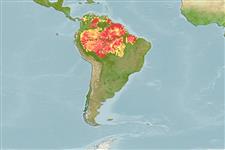Classification / Names
Common names | Synonyms | Catalog of Fishes (gen., sp.) | ITIS | CoL | WoRMS | Cloffa
Actinopterygii (ray-finned fishes) >
Clupeiformes (Herrings) >
Engraulidae (Anchovies) > Engraulinae
Etymology: Anchoviella: Italian ancioa = anchovy (Ref. 45335).
Environment / Climate / Range
Ecology
Freshwater; brackish; pelagic; potamodromous (Ref. 51243). Tropical, preferred ?; 9°N - 4°S, 73°W - 49°W (Ref. 189)
South America: Orinoco system, as far up as Puerto Gaitan on Manacacias River in Colombia, certainly in delta; lower parts of rivers of Guyana, Surinam and French Guiana; lower part of Amazon, but lower limits not known; upper Amazon specimens are not this species.
Size / Weight / Age
Maturity: Lm ? range ? - ? cm
Max length : 11.3 cm TL male/unsexed; (Ref. 80009); common length : 6.0 cm TL male/unsexed; (Ref. 5217)
Dorsal
spines
(total): 0;
Anal
spines: 0;
Anal
soft rays: 14 - 18. Body fairly slender, moderately compressed. Snout short, a little over 1/2 eye diameter; maxilla moderate, tip bluntly rounded, failing to reach pre-operculum by 1/3 to 1/2 pupil diameter; gill cover canals of walkeri-type. Anal fin short, its origin a little behind base of last dorsal fin ray. A silver stripe along flank, widening to about 1/2 eye diameter over anal fin base (Ref. 189).
Occurs in estuaries and rivers, apparently tolerating only very low salinities. Breeds in December: a female of 5.8 cm SL having 2,000 eggs was caught from the Orinoco River mouth (Ref. 12225)..
Spawn in school (Ref. 205).
Whitehead, P.J.P., G.J. Nelson and T. Wongratana, 1988. FAO Species Catalogue. Vol. 7. Clupeoid fishes of the world (Suborder Clupeoidei). An annotated and illustrated catalogue of the herrings, sardines, pilchards, sprats, shads, anchovies and wolf-herrings. FAO Fish. Synop. 125(7/2):305-579. Rome: FAO. (Ref. 189)
IUCN Red List Status (Ref. 115185)
CITES (Ref. 94142)
Not Evaluated
Threat to humans
Harmless
Human uses
Fisheries: subsistence fisheries
More information
ReferencesAquacultureAquaculture profileStrainsGeneticsAllele frequenciesHeritabilityDiseasesProcessingMass conversion
Tools
Special reports
Download XML
Internet sources
